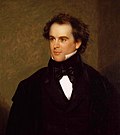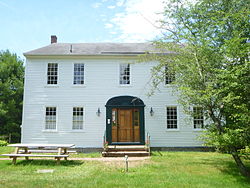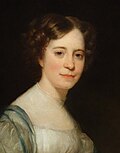Nathaniel Hawthorne
Nathaniel Hawthorne (July 4, 1804 – May 19, 1864) was an American writer. He was born in Salem, Massachusetts. His first novel Fanshawe was published anonymously in 1828. Some short stories were published in 1837 as Twice-Told Tales. He married Sophia Peabody in 1842. They had three children. The family moved about Massachusetts for a few years, but finally settled in Concord, Massachusetts. The Scarlet Letter was published in 1850. The House of the Seven Gables was published in 1851. A political appointment sent Hawthorne and his family to Europe. They returned to Massachusetts in 1860. Hawthorne died on May 19, 1864.
Nathaniel Hawthorne | |
|---|---|
 Nathaniel Hawthorne in the 1860s | |
| Born | July 4, 1804 Salem, Massachusetts |
| Died | May 19, 1864 (aged 59) Plymouth, New Hampshire |
Hawthorne's works belong to the cultural movement called romanticism.[1] His novels and short stories are cautionary tales. They suggest that guilt, sin, and evil are the most inherent natural qualities of humanity.[2] Many of his works are inspired by Puritan New England.[3] They combine historical romance loaded with symbolism and deep psychological themes. They border upon surrealism.[4] His depictions of the past are a version of historical fiction used only as a vehicle to express common themes of ancestral sin, guilt and retribution.[5]
Early life
Hawthorne, a famous short story author, whose childhood was not very good. But many people believe that he was lucky, because he had a wealthy uncle. Hawthorne had two sisters, he was the only son in his family. His father died because of yellow fever when he was four years old. Only his mom took care of him and his sisters. However, Hawthorne’s mother, Elizabeth, had a wealthy brother, so after Hawthorne’s father died, they lived with Elizabeth’s brother. Because of Hawthorne’s wealthy uncle, he attended a very good college, Bowdoin College. During his college time, Hawthorne met and befriended Henry Wadsworth Longfellow, and future-president Franklin Pierce. Hawthorne started to write novels during the time that he came back home after he finished college. He published his first work in 1828.
Influence on society
Hawthorne’s books are still very popular now, as many students are still reading his books today. Hawthorne’s books are very useful in education. As his books reflect many dark parts in American History, they are very good sources to help people learn about history. Also, his books were the very good examples of the Romantic Era of literature.
End of Life
Hawthorne's mother died in 1848 and he became very sad. “The Scarlet Letter” was written down when he was in this condition. In 1851, Hawthorne’s last daughter, Rose was born. Hawthorne had three children, one son, and two daughters. In 1853, President Franklin Pierce gave Hawthorne a political appointment as U.S. Consul in Liverpool, but in 1857, Hawthorne lost this position. Before Hawthorne died, he published his last works, “Our Old Home “ and “The Marble Faun”. On May 19, 1864, Hawthorne died in Plymouth, Massachusetts.
Selected works
- Twice-Told Tales (short stories, 1837)
- Mosses from an Old Manse (short stories, 1846)
- The Scarlet Letter (novel, 1850)
- The House of the Seven Gables (novel, 1851)
- The Snow-Image, and Other Twice-Told Tales (short stories, 1852)
- A Wonder-Book for Girls and Boys (children's stories, 1852)
- Tanglewood Tales (short stories, 1853)
- The Marble Faun (novel, 1860)
Nathaniel Hawthorne Media
Portrait of Nathaniel Hawthorne by Charles Osgood, 1841 (Peabody Essex Museum)
Boston Custom House, Custom House Street, where Hawthorne worked c. 1839–40
Portrait of Sophia Peabody Hawthorne by Chester Harding, 1830 (Peabody Essex Museum)
Daguerrotype of Hawthorne, Whipple & Black, 1848
Commemorative plaque in Blackheath, London
William H. Getchell's 1861 photograph of Hawthorne which inspired the sculpture
References
- ↑ Reynolds, David S. Beneath the American Renaissance: The Subversive Imagination in the Age of Emerson and Melville. Cambridge, Massachusetts: Harvard University Press, 1988: 524. ISBN 978-0-674-06565-9
- ↑ Wayne, Tiffany K. (2006). Encyclopedia of Transcendentalism. Facts on File. ISBN 978-0-8160-5626-2.
- ↑ Bell, Michael Davitt (1971). Hawthorne and the Historical Romance of New England. Princeton, N.J. : Princeton University Press. ISBN 978-0-691-06136-8.
- ↑ Howe, Daniel Walker (2007). What Hath God Wrought: The Transformation of America, 1815-1848. Oxford University Press. ISBN 978-0-19-507894-7.
- ↑ Crews, 28–29








